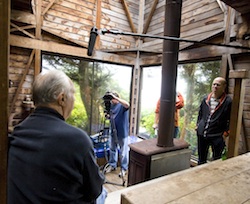By Diana Brement,
JTNews Columnist
It was my kids who spotted Maxx Yamasaki’s name in the Seattle Times. (Yes! My kids read the newspaper!)
“Hey, we went to camp [Kalsman] with him!” they said, pointing to the page.
Maxx, the son of Aleen Kaplan Yamasaki and Psuguhito Yamasaki, was one the winners of the Times’ three-minute cell phone video contest.
The Edmonds-Woodway High School sophomore and Temple B’nai Torah member says he rushed to finish the work in the week allotted, which involved attaching his phone to a tripod made entirely from alligator clips and editing on the iMovie program on his Mac.
He then had the pleasure of seeing his film screened during the SIFF. “I was kind of worried” about cell phone quality translating onto “a big giant screen,” Maxx says, “but when it was shown on the big screen it added a lot. It looked better, sounded better.”
Maxx took a Claymation class about five years ago and now enjoys using the techniques for school presentations. He also plays a little music (drums) and has recently taken to making colorful felt scarves out of wool scraps, which he is hoping to sell on the Internet.
Maxx’s stop-action piece, and the other nominees are at this link: http://bit.ly/9G7hbw (be sure to mind the capital and lowercase letters!). Or, visit the Times’ Web site and enter Maxx’s name in the search bar.
|||
Boaz Ashkenazy wasn’t planning to make a documentary.
The architect’s firm, studio216, specializes in making short promotional videos, film and animation for a long list of respected clients.
“We help them sell their stories about capital projects that are not yet built,” he explains.
But, as a part-time lecturer on the faculty at the University of Washington school of architecture, Boaz had gone one day to hear a lecture on campus about early ’70s architecture in the Northwest.
“I was just listening and thinking, “˜This would be a great story…we need to film these guys,'” he says.
“These guys” are Arne Bystrom, Wendell Lovett, Gene Zema, Ralph Anderson, Fred Bassetti, and others who built their careers — and their buildings — in the ’50s, ’60s and ’70s, becoming known as the Northwest School.
Boaz approached David Miller of Miller Hull, who agreed the film needed to be made and agreed to collaborate on and co-produce what became Modern Views (www.modernviewsfilm.com).
“We started interviewing them…[and] thinking about the story we wanted to tell,” Boaz recalls. Originally, he thought Modern Views would be 20 minutes long, “but it grew and grew and grew,” to 45 minutes (still not that long for a documentary).
The film, co-directed by Amy Enser, premiered at the Museum of History and Industry last month to a sold-out crowd, and played to a standing-room only audience the following week. The reception was “fantastic,” says Boaz, who was surprised that viewers included a lot of non-architects.
“We tried to see it through the eyes of a layperson,” he says, and clearly succeeded.
One message of the film is that these architects were thinking about environmental sustainability long before they were trendy buzzwords. The use of local materials, the preservation of landscape and view, all entered into their design.
While he was born in Israel, Boaz moved with his Israeli dad and American mom to Southern California at the age of 4 and landed in Seattle for graduate studies at the University of Washington in 1999. (He says his distinctly Israeli-sounding name throws native Hebrew speakers who expect him to be fluent. Indeed, I expected him to have an accent.) He and his wife Amy belong to Congregation Beth Shalom and Amy serves on the board of the Seattle Jewish Community School where their three children, Samuel, almost 10, Talia, 7 and Naomi, 4, attend.
Calling architecture “a bridge between this movie and what I do at studio216,” Boaz notes that there is a huge amount of local interest and talent in both architecture and filmmaking, which ups the creative ante around town.
Modern Views screens again on June 14 at Central Cinema on Seattle’s Capitol Hill, and will likely have a longer run at there later this summer. Keep an eye on the movie Web site for ticket and DVD sales and visit www.studio216.com for information about the company’s other work .
|||

Eloquence, by artist Ruth Gendler.
Works by Berkeley-based artist, teacher and poet (or “lyrical non-fiction” as she calls it) Ruth Gendler, are on exhibit at Lakeside Advisors on lower Capitol Hill in Seattle. Growing up in Omaha, Ruth went to Stanford University in the ’70s and started paying frequent visits to her aunt and uncle Goldie and Don Silverman in Seattle. Eventually her sister Beth and her mother Natalie moved here as well, cementing her ties to the area.
Ruth started writing poetry as a child and it’s in her writing that she feels “most connected with Judaism.” However, “when I paint, I find out what I feel,” she says. Her new work features a lot of bowls and vessels, which she calls “very real and also metaphorical for our bodies.” Books, too, are “bowls of words.”
Because Lakeside Advisors is a business — a small investment advisor — you are asked to call or e-mail ahead to see the exhibit running through the end of July. Contact Bob Frey at 206-285-1730 or bob@lakesideadvisors.com. Learn more about Ruth at www.ruthgendler.com.
